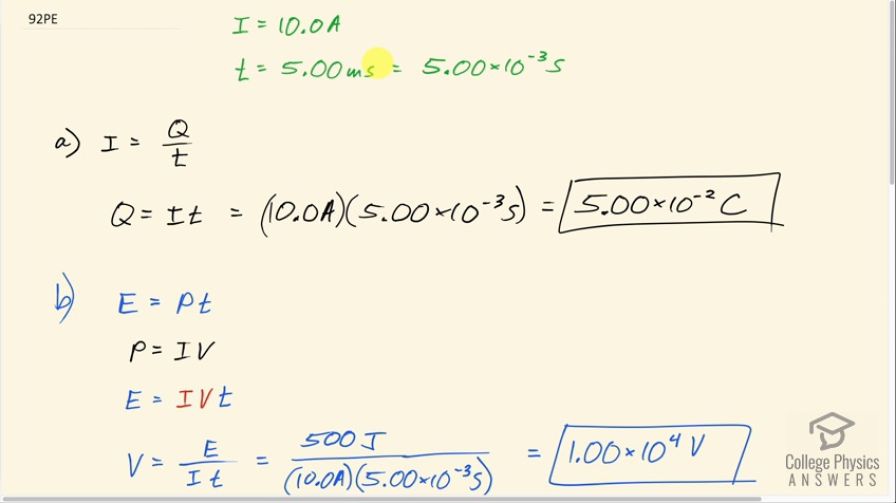Question
A heart defibrillator passes 10.0 A through a patient’s torso for 5.00 ms in an attempt to restore normal beating. (a) How much charge passed? (b) What voltage was applied if 500 J of energy was dissipated? (c) What was the path’s resistance? (d) Find the temperature increase caused in the 8.00 kg of affected tissue.
Final Answer
Solution video
OpenStax College Physics for AP® Courses, Chapter 20, Problem 92 (Problems & Exercises)

vote with a rating of
votes with an average rating of
.
Calculator Screenshots
Video Transcript
This is College Physics Answers with Shaun Dychko. A heart defibrillator passes 10.0 amps of current through the patient in 5.00 milliseconds, which is 5.00 times 10 to the minus 3 seconds and the question in part (a) is how much charge passes? So current is the rate of charge flow or in other words, charge divided by time and so we can solve for the charge Q by multiplying both sides by t. So the charge Q then is the current multiplied by time and that is 10.0 amps times 5.00 times 10 to the minus 3 seconds which is 5.00 times 10 to the minus 2 coulombs. In part (b) we are asked what voltage was applied if 500 joules of energy was dissipated? So the energy is power multiplied by time and power is current multiplied by voltage so we can substitute IV in place of P and have the energy then is IVt and then we can solve for V. We'll divide both sides by current times time and so the voltage then is the energy divided by the current multiplied by time. So that's 500 joules divided by 10.0 amps times 5.00 times 10 to the minus 3 seconds which is 1.00 times 10 to the 4 volts. Part (c) asks what was the path's resistance? Now there's a variety of power formulas involving resistance; we could have also used P equals V squared over R and then use this voltage that we calculated in part (b) to figure out what R is. But just as a cautious approach, I am going to not use a calculated number in subsequent work because then perhaps I have made a mistake in the calculation and then that would also make this next step have an error as well So let's use this formula, P equals I squared over R, and it has just numbers that are given to us by the question because we are going to substitute energy divided by time in place of power and then we solve for R here by dividing both sides by current squared and so the resistance then is the energy dissipated divided by the current squared times time and all these numbers are given to us by the question. So that's 500 joules divided by 10.0 amps squared times 5.00 times 10 to the minus 3 seconds and that is 1.00 kiloohm. Part (d) asks what temperature increase will be caused by this current if there's 8.00 kilograms of tissue through which the current is flowing? So there are two paddles in a defibrillator... if this is a person's body here, and one paddle would be placed here and the other paddle would be placed there and the current is going to go from one paddle to the other and so it's going through 8.00 kilograms of tissue in this mid-torso region. Okay! So we have to look up the specific heat of human tissue which is back in chapter 14, table [14.1], the specific heat of the human body is 3500 joules per kilogram per Celsius degree and we'll use this formula that says the amount of heat absorbed is equal to the mass of the tissue multiplied by its specific heat times its change in temperature. So we want to find out what is ΔT— that's what the question is asking— and so we'll solve for it by dividing both sides by mc. So the energy absorbed divided by mass times the specific heat is the change in temperature. So that's 500 joules divided by 8.00 kilograms times 3500 joules per kilogram per Celsius degree and that is 1.79 times 10 to the minus 2 Celsius degrees temperature increase.
